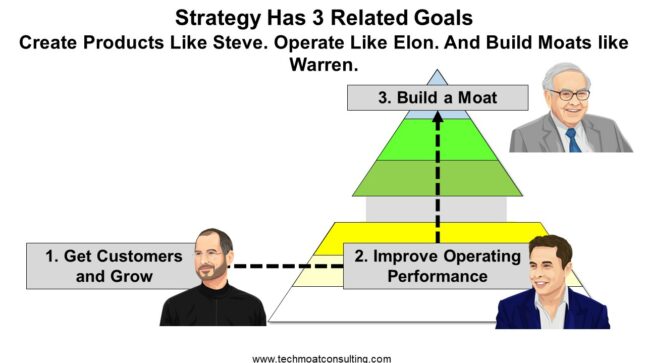There is a lot of talk about moats and dominant business models in Generative AI. What are the winning GenAI strategies for new businesses (like OpenAI) as well as for transforming incumbents (like Microsoft)? And there is quite a bit of commentary by venture capitalists on the types of moats emerging.
I disagree with most of what I’ve read. VCs are just not very good at long-term competition. Unlike equity analytics, it’s not a world they much live in. So, you’ll see lots of simplistic lists, with things like “the 5 types of moats”. And they will list things like brand power, distribution, data advantages, network effects, and so on.
In this series of articles, I thought I would lay out a framework for how to think about winning strategies for Generative AI. And this includes GenAI moats, which are important but only part of a good strategy.
Digital Strategy Is About Achieving 3 Goals
A winning strategy should achieve three inter-related but different goals. Which are:
- Getting customers and growing. Customers are the beginning and end of every business.
- Improving operational performance. You want an operating model that enables excellence.
- Building a moat. If possible, you want a powerful business model that creates protection from competitors. And ideally this is in a valuable position in the value chain.
Here’s my standard slide for digital strategy.

Here’s a version that is easier to remember.

That’s a pretty accurate summary.
- Steve Jobs was exceptional at creating products that people loved and that got mass adoption. And crazy growth. These were technology products and products incorporating new technologies. That’s impressive for a non-engineer who couldn’t write a line of code.
- Elon Musk is an outstanding operator. His companies move at crazy speed and are capable of repeated, rapid innovation.
- Warren Buffett like companies like Coca-Cola and chocolates. They are not great innovators, but they have powerful moats that protect them for decades, if not centuries.
A winning strategy really needs to achieve all three of these goals.
My expertise is in digital strategy. Which means I focus on how strategy must change when a business is under significant technological change. How do these three goals change when something like GenAI bursts on the scene. Suddenly there are new tools and business models changing the game.
That looks like this.

This is why I talk in terms of the three related goals of a winning strategy. Because emerging technologies can change each of these goals differently. It’s good to separate them when thinking about something like GenAI.
I usually focus much more on operating performance (goal 2) and building moats (goal 3). That’s why my books are called Moats and Marathons. And it’s why I write much more about Warren and Elon. New product development and growth tactics are different skill sets.
Ok. So, how is generative AI changing things?
Today, Generative AI is Mostly About Goals 1 and 2.
First, let’s clarify that AI is nothing new in digital business. AI as cheap and fast prediction has been around for decades. What we’re talking about here is generative AI, which is cheap and fast content generation.
Most of what is happening in GenAI today is about creating new products and getting traction. There is a lot of experimentation. Lots of pilots. And some scaling up in in products that are getting traction. That’s Steve Jobs land and goal #1.
We can also see lots of focus on improving operating performance. Generative AI is obviously a huge productivity tool. So, there are lots of pilots and use cases being tested inside companies. Cloud AI companies (which I will talk about) are helping businesses start to incorporate GenAI into their workflows. This is all about goal #2.
However, it’s important to recognize that the right GenAI strategy is going to be very different for incumbents and challengers. What OpenAI and Midjourney are doing is very different than what Microsoft and GE are doing. I’ll get to this in Part 4.
It’s also important to recognize that most businesses should not try to compete for part of the AI tech stack. While there is a lot of attention on OpenAI and Baidu AI Cloud, most businesses are not going to try and big build their own language models. They are not going to be competing for part of the tech stack.
Recall the words of famed technology investor and Warren Buffett influencer Phil Fisher, who said:
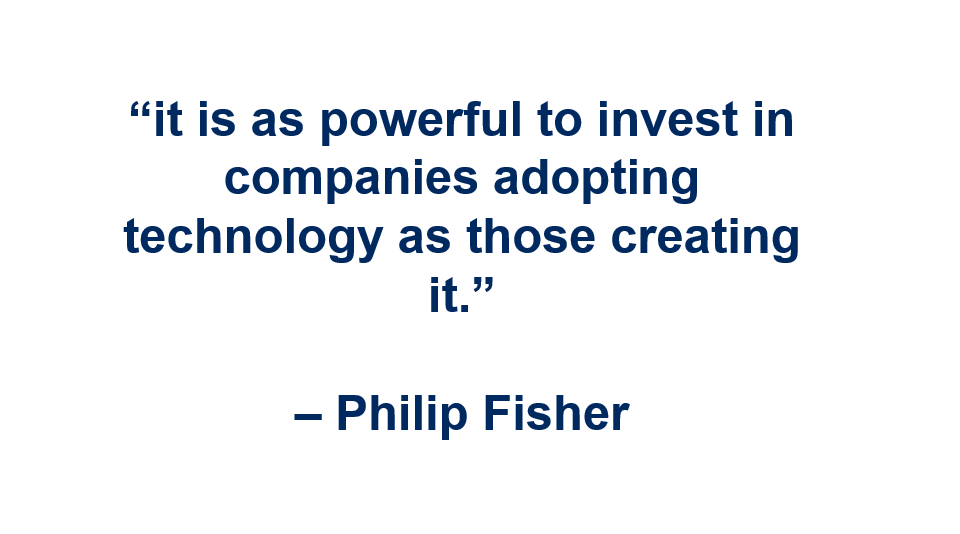
We are mostly talking about companies adopting, not creating, generative AI. Most of the value and competitive strength created is not going to end up with the creators of the GenAI tech stack. It is going to be in businesses that build new products, operations, and business models with this technology.
On a recent video, Chamath Palihapitiya basically said the same thing Phil Fisher said:
“The people and the person that invented refrigeration made some money. But most of the money was made by Coca Cola who used refrigeration to build an empire.” – Chamath Palihapitiya
***
Ok. That is a simple first pass framework for thinking about generative AI.
- Think about the three goals of a winning strategy.
- Most of the applications of Generative AI today are in putting it into products (#1) and improving existing operating performance #2).
Based on this, here is Step 1 of a playbook for Generative AI.
Every Business Needs to Experiment with Putting GenAI in Products and Services ASAP.
Most of the discussion today around generative AI is around new products, the emerging tech stack and new use cases. There is some focus on scaling up. A lot of the discussion about generative AI is still at the product development, experimentation, and tactics stage.
I put this all under the heading of “do whatever works”. New businesses are struggling to get traction with something somewhere. So are incumbents, although with less urgency. And those finding traction are using money to grow. And as a competitive weapon (subsidies, free products, marketing, etc.)
Here’s my standard list for this, which is the bottom of my strategy pyramid.
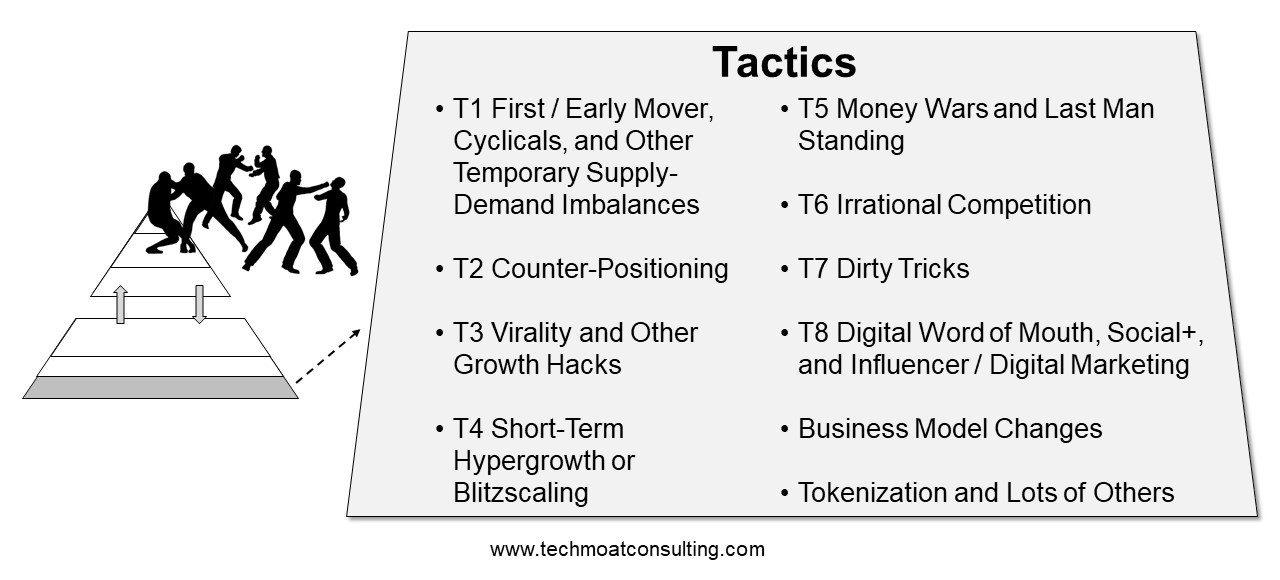
You can see a lot of the GenAI discussion is really just about product experimentation and tactics.
And product development, growth and tactical moves are generally much easier for an incumbent than for a challenger. Incumbents have lots of advantages here (capital, resources, distribution, customers, etc.). They also have the ability to link to their existing products and businesses. So, incumbents tend to do well here.
Challengers are usually much smaller and lack resources. Their primary advantages are usually speed and being an early mover in a new type of technology or product. They need to get their first, move faster and get to scale before the incumbents catch them. Sometimes, they can also do counter-positioning (T2) against incumbents.
The playbook for incumbents and challengers is pretty much the same in these areas.
- Product development (i.e., Steve Jobs land).
- Launch entirely new products. Go for a 10x improvement in the user experience.
- Put GenAI into existing products and services. Challengers need to be early movers and fast.
- Tactics:
- Get ready for a brutal money war.
- Watch for blitzscaling.
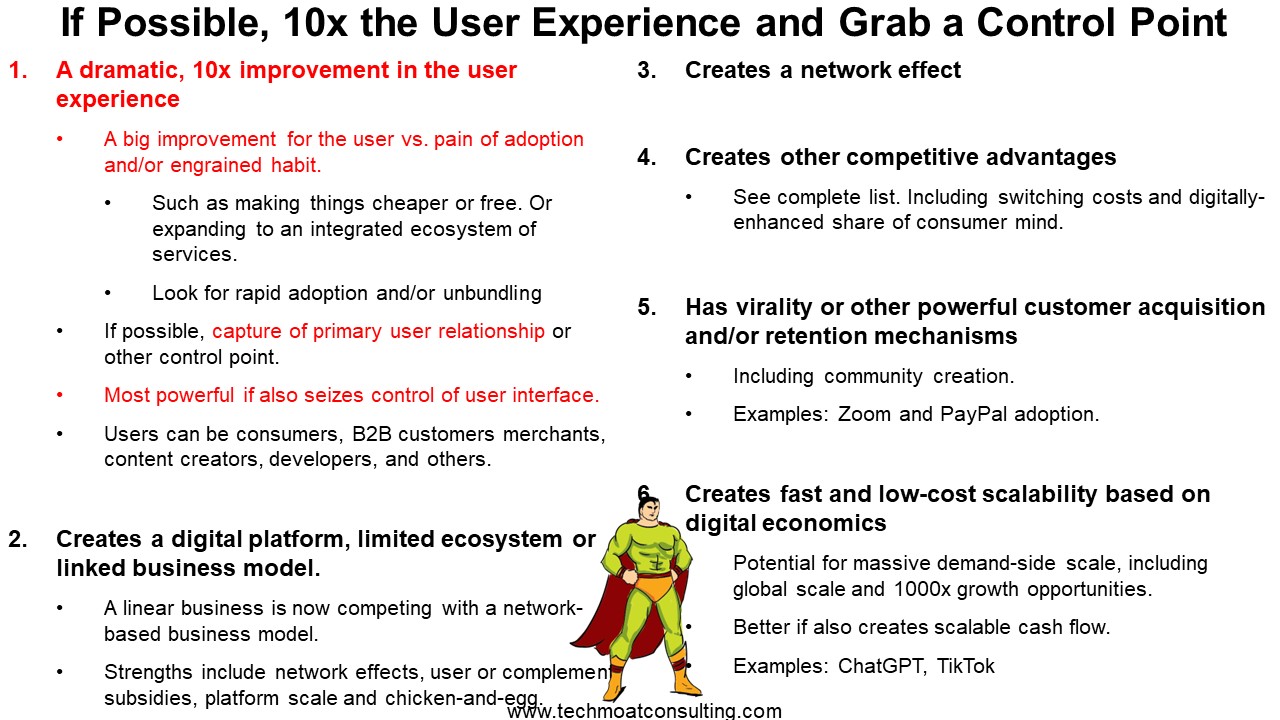
Businesses Need to Start Building the GenAI Operating Basics.
As products and tactics prove themselves to be working in GenAI, they will become more regimented and operationalized within the company. Basically, after you figure out what works, you build operating systems around that.
For software and data technologies, I have been calling this the digital operating basics. Which pretty much every business now has to build.
But now we are seeing a new AI value chain, a new AI tech stack and lots of new activities that are going to be essential. Unfortunately, the digital operating basics have been expanded. And businesses are now going to have to put in place the Digital and AI Operating Basics.

It isn’t actually a different set of operating activities. They are pretty much the same. But there’s definitely a new AI tech stack and lots of new staffing and skills requirements.
In practice, that means:
- Businesses will need a new AI core for management and operations. DOB3 now includes an AI core with completely different technology. And this will need to be integrated into both management and operations.
- Businesses will need new staff and skills. DOB6 now include AI people, skills, and training. This means:
- Lots of new talent recruiting and GenAI upskilling. Lots of hiring and training.
- Staff starting to use GenAI as “copilots” in their core activities. This will make them dramatically more productive and effective.
- Starting to deploy GenAI as “autopilots”. This is the beginning of a non-human workforce to complement the human workforce.
This all goes under Goal #2 (i.e., Elon Musk land).
***
So Step 1 of the GenAI Playbook is pretty much these three slides.
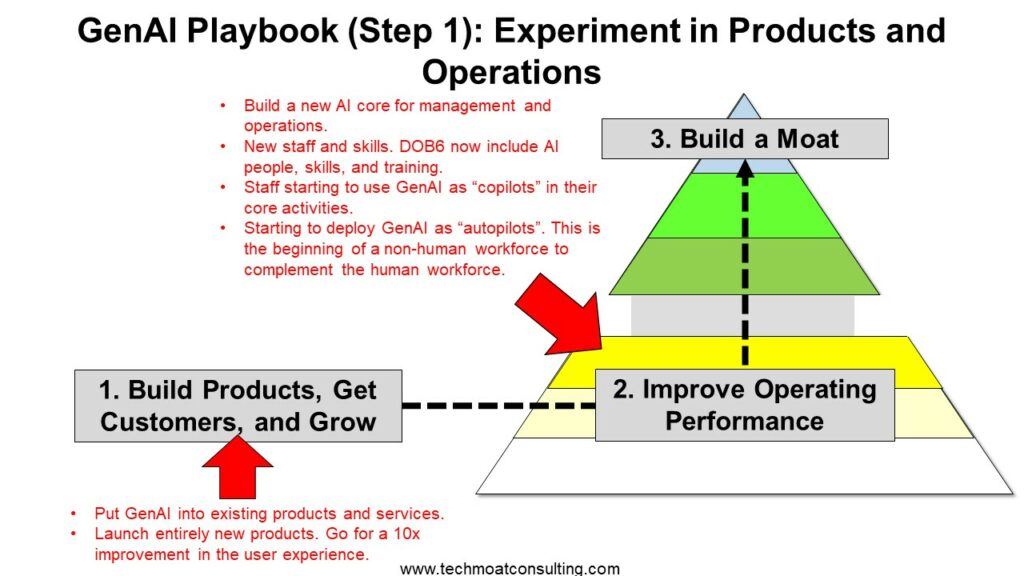
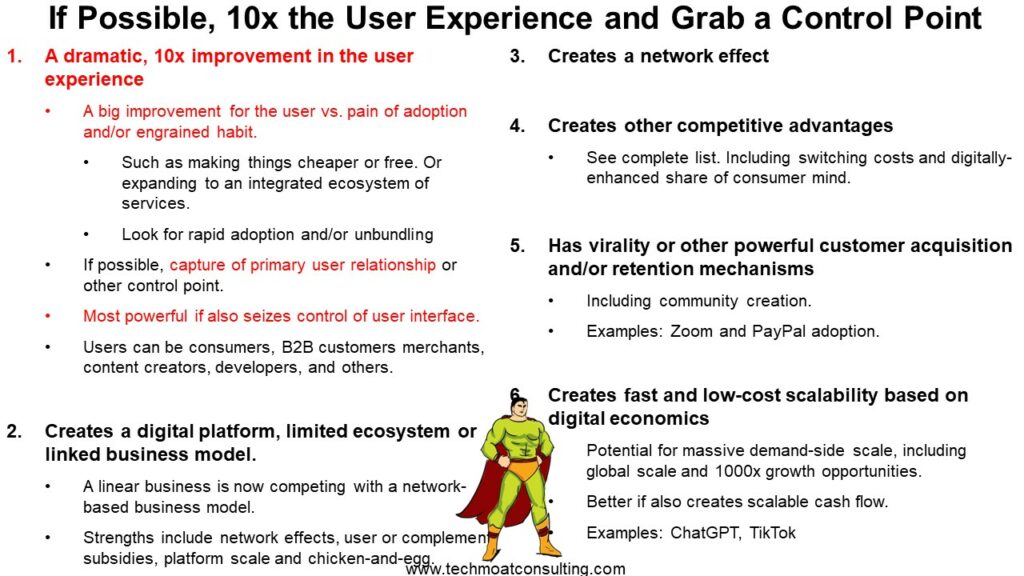

As for moats, much of the GenAI moat discussion has centered on being vertically integrated or not. Can you be just a foundation model? Should you be an app with an integrated model (i.e., Midjourney)?
Most moats don’t come from vertical integration. They come from competitive advantages in certain activities. And you want to understand this granularly. That’s what I’ll start to do in Part 2.
Cheers, Jeff
——-
Related articles:
- AutoGPT and Other Tech I Am Super Excited About (Tech Strategy – Podcast 162)
- AutoGPT: The Rise of Digital Agents and Non-Human Platforms & Business Models (Tech Strategy – Podcast 163)
- The Winners and Losers in ChatGPT (Tech Strategy – Daily Article)
- Why ChatGPT and Generative AI Are a Mortal Threat to Disney, Netflix and Most Hollywood Studios (Tech Strategy – Podcast 150)
From the Concept Library, concepts for this article are:
- Generative AI
- AI Strategy
From the Company Library, companies for this article are:
- OpenAI / GPT / DALL-E
- Google / Bard
- Huawei Cloud
———
I am a consultant and keynote speaker on how to accelerate growth with improving customer experiences (CX) and digital moats.
I am a partner at TechMoat Consulting, a consulting firm specialized in how to increase growth with improved customer experiences (CX), personalization and other types of customer value. Get in touch here.
I am also author of the Moats and Marathons book series, a framework for building and measuring competitive advantages in digital businesses.
This content (articles, podcasts, website info) is not investment, legal or tax advice. The information and opinions from me and any guests may be incorrect. The numbers and information may be wrong. The views expressed may no longer be relevant or accurate. This is not investment advice. Investing is risky. Do your own research.
